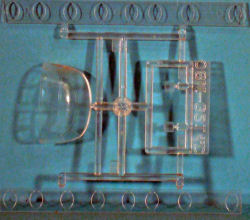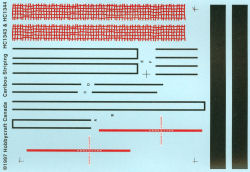
Hobbycraft 1/48 DHC-4 Caribou Kit First Look
By Michael Benolkin
| Date of Review | June 2008 | Manufacturer | Hobbycraft |
|---|---|---|---|
| Subject | DHC-4 Caribou | Scale | 1/48 |
| Kit Number | HC1343 | Primary Media | Styrene |
| Pros | Simple build, unique subject | Cons | |
| Skill Level | Basic | MSRP (USD) | $40.00 |
First Look
 |
 |
 |
 |
 |
 |
In the late 1950s, the de Havilland Company in Canada developed the next step in their Short Take-Off and Landing (STOL) utility aircraft - the Caribou. This was a rugged airframe powered by a pair of Pratt & Whitney Twin Wasps that could get troops and priority cargo into airfields that were too small for the C-123 or C-130. The US Army purchased 159 of these aircraft as the CV-2 (later designated as the C-7). During Vietnam, these aircraft proved invaluable to supporting resupply beyond the range of helicopters. These aircraft also proved versatile to operators in Australia, Brazil, Canada, India, Malaysia, Spain, and even Air America.
Some 20 years after the US Air Force became a separate service from the US Army, the Air Force was able to convince the Pentagon that it should strip the Army of its fixed-wing assets, seeing that Army airlift was a competitor to the Air Force's own airlift mission. The C-7 Caribou was transferred to the USAF, who continued Caribou operations for a time, but then found the Caribou to be 'redundant' to the LAPES (Low Altitude Parachute Extraction System) cargo delivery capabilities of the C-130.
During this time, the Air Force was also pushing to discontinue piston-engine operations in favor of a pure turbine force for several reasons, not the least of which is to eliminate the expense of transporting, storing, and supporting AvGas and jet fuel around the world. C-7s were transferred to the South Vietnamese Air Force as well as to other users. de Havilland also recognized the power and reliability of the turboprop engine and developed the DHC-5 Buffalo, and while the US Army had selected the Buffalo for US Army service, this contract was never awarded due to the transfer of fixed wing operations to the USAF.
The Caribou and Buffalo were a little ahead of their time. Only in recent years has the USAF airlift community recognized the need for a smaller class of airlifter to support theater operations as C-130 time is being used more often than not performing small cargo deliveried around the theater. With the C-130 currently at the bottom of the USAF's airlift ladder (with the C-17, C-141, and C-5 on the higher rungs), the USAF finally procured a lighter-twin-engine airlifter with the C-27J Spartan. While the USAF has operated smaller twins since Vietnam such as the G.222 and Sherpa, these were never widely deployed.
Here is a kit from Hobbycraft Canada that has been around for a while, but has not been noticed very much in the community. This is a 1/72nd scale rendition of the Caribou that is really a simple build.
The kit is molded in light gray styrene and presented on three parts trees, plus a single tree of clear parts. The kit offers a basic flight deck, and with none of the doors or hatches molded separately, there is no need for an interior. Detailing is scribed and the kit does have a separately molded radome for the nose. While the US Army had radars on their aircraft, other operators like the RAAF didn't have radars (at least initially).
What about all of those windows in the fuselage? Hobbycraft did something really interesting here. You install the windows, spay a clear finish on the interior (Future or some equivalent) to provide a base for decals. See that pair of distorted red mesh decals? Those simulate the red web seating found in many airlifters and were usually visible in the windows of the Caribou.
Simple lay those two decals over the side window strips, then layer the black decal strips over the top of them to black-out the windows, and you've now simulated interior shadow behind the web seating when viewed from outside. Alternatively, I would suggest eliminating the black decal strips and painting the interior black instead so the viewer will have the perspective of seeing through the web seats and out the other side of the aircraft.
You'll need a serious load of ballast in the nose of this model to offset the aft center of balance of this model (or else you'll have a dedicated tail sitter on your shelf).
The kit has simple engine face plugs for inside each nacelle. AMS modelers will probably want to find some Twin Wasps (or visual equivalent) to shove inside those cowlings to provide some realistic depth and detail.
In this release, Hobbycraft has provided markings for three aircraft:
- C-7A, 24171, 61st Aviation Company, US Army, Vietnam, 1964
- Caribou, #73, Royal Australian AF, Vietnam, 1964
- C-7A, 63-0744, 427 Trans Sqn, Da Nang, South Vietnamese Air Force, 1973
This is a simple build project that will please most modelers while providing an excellent opportunity for the AMS modeler to do a little "tweaking" here and there to enhance the look and detail of the model. A real AMS modeler would drop those full-span STOL flaps!
My sincere thanks to Hobbycraft Canada for this review sample!







